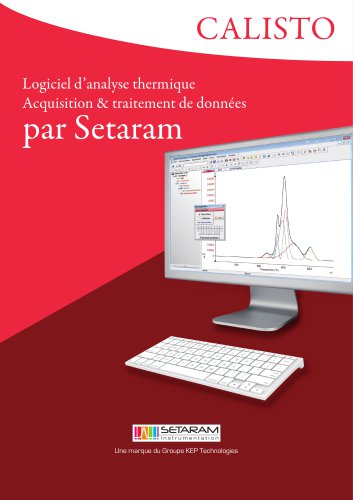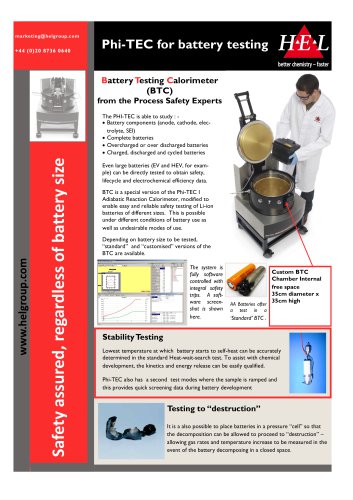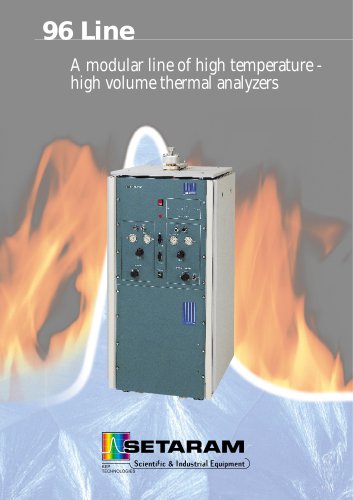
Catalog excerpts

Energy § Environment – Energy Storage Materials – TN681 Thermal Analysis and Calorimetry applied to Thermal Energy Storage (TES) Introduction The Thermal Energy Storage (TES) is defined as the temporary storage of thermal energy at high or low temperatures. As most of the renewable energy sources (solar, wind, …) are intermittently available, the target of TES is to improve performances of energy systems with a smoother supply and an increased reliability. Three main types of thermal energy storage have to be considered (Figure 1): - Storage of sensible heat - Storage of latent heat - Storage of thermochemical heat For each TES mode, various types of transformations or reactions are available and are well known. This application note will demonstrate how the thermal analysis and calorimetric methods are used to investigate the different TES techniques and to characterize the materials (solid and liquid) used in the corresponding processes. Figure 1: Presentation of the different Thermal Energy Storage (TES) modes (from Fraunhofer IGB website) Sensible heat When heating or cooling a liquid or a solid without changing phase, the method is called sensible energy storage. The sensible heat of a substance corresponds to the amount of energy required to raise or cool the temperature of the material on a given temperature range. This sensible heat is related to the heat capacity Cp of the material and is related to the following relation between T1 and T2: T2 www.setaram.com sales@set
Open the catalog to page 1
dq dT = mC p dt dt where - dq/dt is the DSC signal - dT/dt is the temperature scanning rate The first DSC technique for measuring the heat capacity is called the continuous heating (or cooling) mode (Figure 2). A linear heating rate is applied between T1 and T2. The As deviation corresponding to the DSC signal of the sample is corrected from the Ab deviation corresponding to the DSC signal of the blank curve (obtained with two empty crucibles). Exo Continuous method Figure 2: Cp determination in the continuous heating mode The second DSC technique, called the step heating (or cooling) mode...
Open the catalog to page 2
HeatFlow Cp Step Example (mW) Step method HeatFlow Blanc Cp Step Example (mW) Energy § Environment – Energy Storage Materials – TN681 Figure 3: Cp determination in the step heating mode According to the type of material (solid or liquid), the range of temperature to be investigated, SETARAM provides calorimeters and DSC’s to work from -196°C up to 1600°C for Cp determination. The following table gives a list of the different calorimetric devices with their range of temperature, the Cp mode that can be applied, the volume available for the sample, the expected accuracy (for more information...
Open the catalog to page 3
Energy § Environment – Energy Storage Materials – TN681 Latent heat All pure substances are found under three different states: solid, liquid and vapour. To go from one state to anther, addition or removal of heat is required. The heat that causes these changes is called latent heat. Latent heat does not affect the temperature of a substance as this temperature will remain constant during the whole process of transformation (Figure 4). Latent heat is mainly coming from melting or crystallization, vaporisation or condensation. The use of the latent heat of a material allows to bring a...
Open the catalog to page 4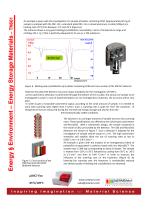
Energy § Environment – Energy Storage Materials – TN681 An example is given with the investigation of a sample of plaster containing PCM. Approximately 50 mg of sample is analyzed with the DSC 131, a standard plate DSC, into a closed aluminum crucible (100µL) at a heating rate of 3°C/min between -5°C and 45°C (Figure 6). The material shows a very good melting/crystallization reversibility in term of temperature range and enthalpy (25.1 J.g-1) that is perfectly adequate for its use as a TES substance. Cp/J/g.K Heat Flow/mW Figure 6: Melting and crystallization of a plaster containing PCM and...
Open the catalog to page 5
Cooling Cooling Heating Heating Enthalpy (mJ/mg) Energy § Environment – Energy Storage Materials – TN681 Figure 8: Experimental DSC melting and crystallization profiles of the tested PCM at 0.04°C.min-1 and 1°C.min-1 Figure 9: Enthalpy variations of the tested PCM during heating and cooling at 0.04°C.min-1 and 1°C.min-1 The enthalpy variation of the tested PCM seen on Figure 9 clearly shows the influence of the scanning rate for the definition of the correct temperature range for an appropriated thermal energy storage. Calorimetry also offers the possibility to work on large amounts of...
Open the catalog to page 6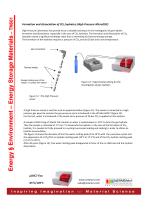
Energy § Environment – Energy Storage Materials – TN681 Formation and dissociation of CO2 hydrates (High Pressure MicroDSC) High Pressure Calorimetry has proved to be a valuable technique in the investigation of gas hydrate formation and dissociation, especially in the case of CO2 hydrates. The formation and dissociation of CO2 hydrates evolve a significant enthalpy value that is interesting for thermal energy storage. The formation of the hydrates requires a pressure of CO2 around 20 bar and a low temperature. Thermal shields Sample holding part of the vessel, in contact with sensor Figure...
Open the catalog to page 7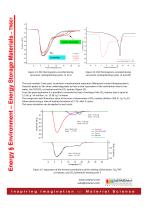
Hydrate dissociation After 5 cycles (-20 -> 70°C) After 28 cycles (-15 -> 5°C) Figure 13: DSC thermograms recorded during successive cooling/heating cycles (1 to 5) Figure 14: DSC thermograms recorded during successive cooling/heating cycles (5 and 28) The cycle number 5 was used to perform a mathematical separation (Marquard routine fitting assymetric Gaussian peaks) on the three underlying peaks to have a clear separation of the contribution due to free water, the THF/CO2 co-hydrate and the CO2 hydrate (Figure 15). From the peak separation it is possible to evaluate the heat of melting of...
Open the catalog to page 8
For thermochemical energy storage, the principle is to use the heat that is evolved during the following reversible reaction: A (solid) ←→ B (solid) + C (gas) This type of reaction based on the adsorption (exothermic)/desorption (endothermic) process is achieved with different types of sorbents: - Silicates, silica gels, silica aerogels, ordered mesoporous silicates (MCM, SBA) - Zeolites - Metal aluminophosphates - Metal Oxide Frameworks MOF’s - Composites : salts + sorbates such as water, methanol, ethanol, ammonia The calorimetric and thermogravimetric techniques have been used for many...
Open the catalog to page 9All SETARAM Instrumentation catalogs and technical brochures
-
CALISTO
4 Pages
-
BTC
2 Pages
-
96 Line TMA
8 Pages
-
AlexSys
4 Pages
-
SOLUTIONS-STA-TGA-EGA
3 Pages
-
96 Line DTA / DSC
8 Pages
-
LABSYS evo DTA/DSC
5 Pages
-
TCi
6 Pages
-
Brochure-LABSYS evo
5 Pages
-
C80
8 Pages
-
Poster-µDSC7 evo
1 Pages
-
µDSC7 evo
3 Pages


